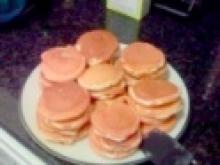I've written about the basic American pancake
here. I've even linked to an easy and clearly presented step-by-step recipe by Ree Drummond, for Perfect Pancakes. In all seriousness, listen to The Pioneer Woman. Ree's recipe and procedure works. It's a case of someone who has a thoroughly tested and completely proven recipe and procedure. Don't mess with it. It works. But there are some other things, besides following a really great recipe, that you can do to have perfect pancakes.- Don't make the batter before you're about to cook it. Go ahead and mix the dry ingredients, but wait to add the wet ingredients. The chemical reactions that cause leavening will stop working if you wait too long between mixing the batter, and cooking. Ten minutes after mixing and before you start cooking the pancakes is about right.
- Don't overmix. Really. You want to have the dry ingredients mixed with the wet ingredients but not, as Ree Drummond puts it, "beaten to death." It's ok to have a few lumps; you want to moisten all the dry ingredients, and disperse the liquids evenly. Doing more than that results in tough, chewy pancakes.
- You want a cooking surface, whether it's skillet or an actual griddle, that's flat and that heats evenly. That means thicker is better than thinner, since you can turn down the heat and still cook using residual heat.
- Watch the temperature. The danger is less one of over cooking, or burning, than one of not having the cooking surface hot enough. Test the griddle or pan by sprinkling hot water on it; if it's hot enough, the water drops will skitter and dance across the surface of the griddle.
- Don't use butter to oil your cooking surface; it doesn't do well with high heat, and can cause odd blotches on the pancakes. Use canola oil, or bacon fat (I know, I know--just wipe out the pan with a paper towel so that there's a little there, and re-apply using the paper towel), or even canola oil Pam.
- Pancake size dramatically affects cooking time. Smaller is easier to control than large. I like to use about 1/4 cup of batter in a measuring cup; just dip it in the batter, and gently pour it on the pre-heated cooking surface. If pancake appearance is more important than haste, a large bottle with a squeezable pour spout, like a large bottle that once held salad dressing or ketchup, that you've cleaned and filled with pancake batter, gives you amazing control over the size and shape of your pancakes.
- When bubbles start to form in the pancake, not just one or two but several, and the edges are a little brown, gently flip the pancakes and cook the other side. The second side will cook much more quickly; don't be fooled into over-cooking them.
- Don't use corn-syrup based fake maple syrup. The real stuff is much more affordable if you buy the better-tasting but darker grades, like B Amber and B B Dark Amber. Alternatively, just a little butter, or fruit preserves, or marmalade, or a bit of powdered sugar and fresh lemon juice all work really well.
